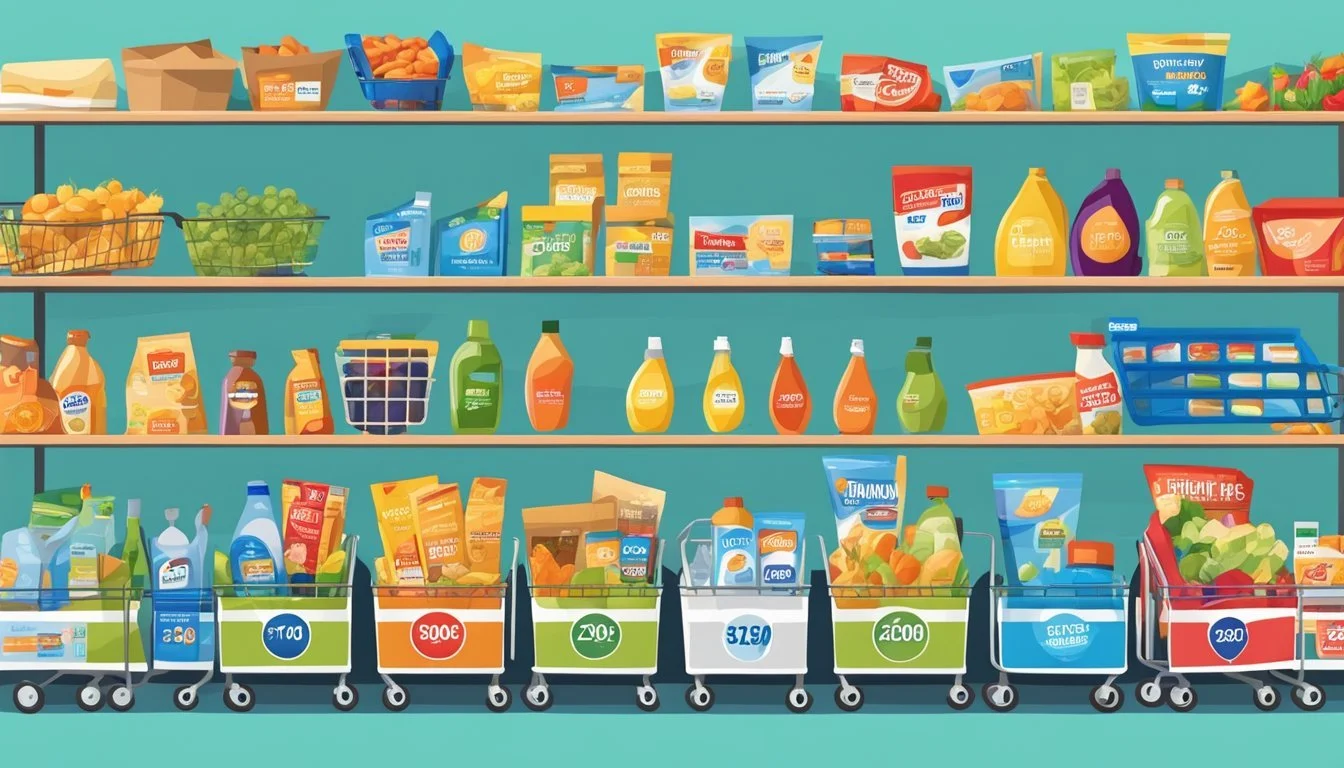Is Walmart Cheaper Than Meijer?
A Cost Comparison Guide
Part of Our Grocery Store Guide with Details on Walmart Prices and Meijer Prices
Comparing prices between major grocery retailers is a common concern for shoppers aiming to make the most of their budgets. Walmart, a retail giant with a global presence, has built a reputation for offering low-priced goods across a broad range of products. Meijer, a supercenter chain predominantly found in the Midwest, also offers a competitive selection of grocery items. With both stores vying for the attention of price-conscious consumers, a side-by-side price comparison can shed light on which store offers better value for everyday shopping.
Analysis of recent pricing data indicates that Walmart generally maintains a slight edge in pricing across various categories, being consistently inexpensive and making it a go-to option for budget grocery shopping. On the other hand, Meijer sometimes offers lower prices on specific items, particularly when factoring in weekly sales and promotions. Store enthusiasts often highlight Meijer’s competitive employee pay and regional product offerings as part of the store's appeal. Despite these nuances, both Walmart and Meijer remain strong contenders within the US grocery market, and price differences may not be substantial enough to sway consumer loyalty in most cases.
Overview of Walmart and Meijer
When assessing the retail landscapes of companies like Walmart and Meijer, it's essential to explore their origins, expansion, and the scale of their current operations.
History and Growth
Walmart laid its first stone in 1962 in Rogers, Arkansas. It was founded by Sam Walton with the primary vision of offering lower prices to get higher sales volumes. Its growth trajectory has been profound, cementing its status as a global retail giant.
Meijer, a bit older, started its operation in 1934. Hendrik Meijer opened the first store in Greenville, Michigan. It is credited as a pioneer of the hypermarket concept in the US, and, similar to Walmart, has experienced a steady growth pattern.
Store Footprint
As of 2024, Walmart operates a vast network of stores across the United States and beyond. It has a strong presence with thousands of stores serving millions of customers daily.
Locations: Nationwide across the US, including states like Indiana, Wisconsin, and Illinois.
Meijer, though smaller in comparison to Walmart, has a significant footprint in the Midwest. It operates several hundred stores and it's especially prevalent in states like Michigan, Ohio, Indiana, Illinois, Kentucky, and Wisconsin.
Type of Stores: Both retailers offer a variety of store formats, including hypermarkets which combine groceries and departmental shopping in one location.
Each company has strategically optimized its locations to cater to a wide demographic, maintaining a strong presence where they operate.
Price Comparison Analysis
This section dissects the pricing strategies of Walmart and Meijer and outlines specific price points for a clear understanding of where consumers might find the best value.
General Pricing Strategy
Walmart is renowned for its commitment to low prices across a broad range of products. Its large buying power and cost-saving strategies enable it to provide notable savings on groceries and consumer goods. In contrast, Meijer, a smaller chain compared to Walmart, also offers competitive prices, with occasional lower prices on selected items, especially when utilizing its weekly sales flyers to strategize shopping.
Specific Price Points
When comparing specific items, shoppers may notice marginal differences in pricing. For instance:
Grocery items: At Walmart, a basket that includes various grocery products tends to offer the best overall value compared to Meijer, with total costs at the checkout being marginally lower.
Item Walmart Price Meijer Price Total (34 items) $70.46 $69.94 Grocery Basket $119.44 $126.35
Note: The prices may vary based on weekly deals and discounts.
Sales and discounts: Meijer's weekly flyers can result in savings on specific items that might make it cheaper than Walmart for those goods on sale. However, these are time-sensitive and require consumers to plan their purchases around the sales cycle.
By comparing the specific price points within each store's inventory, customers can identify which retailer might provide the best value for their shopping list on any given week.
Product Assortment and Selection
When comparing Walmart and Meijer, it's important to consider the vast range of products each store offers within their categories. Shoppers evaluate their options based on the variety of items available in specific shopping categories such as grocery, fresh produce, clothing, electronics, and more.
Grocery and Fresh Produce
Walmart's grocery section boasts a comprehensive selection of items across multiple categories including dairy, meat, and fresh produce. They provide an extensive variety of both national and generic brands covering the needs of a diverse shopper base. Meijer's strength in the grocery arena lies in their commitment to freshness, particularly in their produce, offering high-quality fruits and vegetables which are a staple for shoppers seeking fresh food options.
Non-Grocery Items
In the realm of non-grocery items, both retailers excel but with varying focuses. Walmart is well recognized for their expansive electronics department, alongside offerings in clothing, health, and beauty. Their product range also extends into household goods, catering to a broad spectrum of consumer needs. Meijer, while also stocking a wide range of clothing, electronics, and household items, places a significant emphasis on their pharmacy services, vying for consumer loyalty through health-related products and services.
Private Label Brands
Both retailers feature a selection of private label or store brands, which provide cost-effective alternatives to name brands. Walmart's store brands, such as Mainstays for household goods and Great Value for grocery items, are positioned as affordable alternatives without compromising quality. Meijer's store brand products similarly offer competitive prices, particularly in pantry staples and household essentials. Each retailer's store brands are strategically developed to cover a wide range of shopping categories, effectively catering to budget-conscious consumers.
Quality and Brand Comparison
When comparing Walmart and Meijer, consumers often weigh the balance between quality and cost. Both retailers offer a variety of products encompassing name brands and store brands, presenting different value propositions.
Perception of Quality
Consumers typically associate name brands with higher quality due to long-standing reputations and consistent product performance. Walmart and Meijer stock a multitude of these name brands, which are favored for their reliability and consumer trust. The quality perception of these name brand items at both stores remains relatively consistent with what shoppers find elsewhere. However, the quality perception of store brand items can vary. Walmart's store brand, Great Value, is recognized for offering acceptable quality at affordable prices. Similarly, Meijer's store brand, Meijer Brand, is perceived to provide a satisfactory quality level for its cost, often being compared favorably with name brand counterparts.
Brand vs. Generic
Aspect Name Brand Items Store Brand Items Quality Generally high Ranges from low to high Value Dependable, costlier High value, cost-effective Products Diverse selection More limited selection
Name brands command a premium because they often invest more in ingredients, production, and quality control. This results in a consistent product that consumers trust. Shoppers at both Walmart and Meijer have known these brands for years and usually equate them with peace of mind regarding quality. In contrast, store brand products provide consumers with a more cost-effective alternative that can offer similar or variable quality. While the value proposition is high due to lower prices, the quality range of generic or store brand products can differ significantly, with some matching name brands and others falling short. Customers often choose these products when they are willing to compromise on quality for the sake of value.
Shopping Experience
The shopping experience at both Walmart and Meijer has distinct characteristics that influence customer satisfaction, from the ease of navigating the stores to the level of customer service and online integration.
Store Layout and Design
Walmart stores are designed with a focus on low-cost and efficiency, featuring wide aisles to accommodate high customer volume and typically a logical flow from groceries to general merchandise. Alternatively, Meijer stores often provide a more department store-like feel with separate areas for groceries, clothing, electronics, and home goods, potentially enhancing the browsing experience.
Customer Service
Customer service is a crucial aspect of the shopping experience. Meijer often receives recognition for friendly staff who offer personalized assistance. On the other hand, Walmart places a significant emphasis on self-service options but may sometimes have fewer staff available on the floor, which can impact the speed and quality of in-store assistance.
Online Shopping and Services
Both stores have expanded their services to include online shopping options. They offer store pickup and delivery services, but Walmart edges ahead with a more robust online infrastructure comparable to giants like Amazon. Walmart's website and app are typically deemed user-friendly, integrating their in-store and online services effectively, often seen with their rollout of Walmart+ subscription service. Meanwhile, Meijer's digital presence has been improving, with its mPerks rewards program creating personalized deals, showing a commitment to enhancing their online customer engagement.
Both Walmart and Meijer provide experiences tailored to different customer preferences, from in-person shopping encounter to online service utilization.
Deals and Discounts
When comparing Walmart and Meijer, each retailer offers unique opportunities to save money through different strategies including regular sales, promotions, and loyalty programs. Customers keen on maximizing their savings should familiarize themselves with these schemes to benefit from reduced prices.
Regular Sales and Promotions
Walmart traditionally maintains a competitive edge with consistently low prices, bolstered by frequent rollbacks and special buy deals. Customers can expect regular weekly sales across various departments, from groceries to electronics, facilitating savings on a wide array of products.
Rollbacks: Temporary price reductions on select items.
Special Buys: Limited-time offers on new and popular products.
Meijer focuses on tailoring its sales to regional preferences, often featuring promotions linked to local events or seasons. They utilize weekly sales flyers that highlight discounts across their range, potentially resulting in notable savings for consumers who plan their shopping around these deals.
Weekly Flyers: Highlighted discounts on a range of products.
Seasonal Sales: Targeted savings during holiday seasons and regional events.
Loyalty Programs and Coupons
Both retailers offer loyalty programs that provide additional savings on top of in-store sales. These programs are designed to reward regular customers with further discounts and exclusive offers.
Walmart's loyalty initiatives are less about points and more about convenience and price matching. They offer a savings catcher within their app, which compares prices to give customers the difference if a better deal is found elsewhere.
Savings Catcher: Price comparison tool within Walmart's app.
Meijer operates a more traditional loyalty program known as mPerks, which provides personalized rewards, digital coupons, and trackable savings over time.
mPerks: Personalized rewards and digital coupons system.
Digital Coupon Hub: A place to find and clip digital coupons applicable to in-store and online purchases.
Geographic Pricing Variations
When comparing Walmart and Meijer, one must take into account how pricing can vary based on location. Factors such as local economic conditions, real estate costs, and regional competition can lead to variations in price for both overall and specific items.
Local vs National Pricing
Walmart tends to adopt a more national pricing strategy, aiming for consistency across its stores. Prices at Walmart might show minor local variations to remain competitive, but the retailer often leverages its expansive network to maintain uniform pricing. In contrast, Meijer, primarily located in the Midwest, may adjust its prices on a more local basis, reflecting the economic conditions of each community it serves.
Regional Price Differences
Supermarkets like Meijer, which are entrenched in regional markets like the Midwest, often have a keen understanding of local preferences. These insights allow them to tailor their price strategies across different regions, sometimes offering deals that appeal specifically to local markets. For example, in a state like Kentucky (KY), Meijer could have different pricing for items that are culturally significant to the local grocery shoppers compared to a store in another state. Walmart also follows a regional pricing model to an extent but primarily maintains its low-price identity across various US states and even multiple countries.
Prices at both retailers may also differ based on proximity to supply centers or distribution warehouses, with those closer to these facilities potentially enjoying lower prices due to reduced shipping costs.
Consumer Behavior and Preferences
When considering whether Walmart or Meijer offers better value, consumers exhibit specific shopping habits and preferences that influence their choice. These behaviors are guided by the desire to save, the balance between cost and quality, and the search for the best deals to fulfill their grocery list needs.
Shopping Habits
Customers often gravitate towards Walmart or Meijer based on their weekly shopping habits. Families looking to save on their grocery bill may choose Walmart due to its reputation for lower prices on a broad range of items. Walmart’s large store footprint also means convenience for many shoppers, which can influence where they decide to shop. On the other hand, Meijer can attract customers with its weekly sales flyer, which savvy shoppers use to create their grocery lists and plan meals around discounted items.
Walmart: Known for everyday low prices across various product categories.
Meijer: Offers weekly deals that can lead to significant savings on specific items.
Preferences for Discount vs. Quality
While discounts may draw in some customers, others are more concerned with quality and overall value. Despite Walmart's edge in lower prices, Meijer customers may find more value in the quality of certain products like fresh produce or in-store brands. Customer service also plays a role in shaping shopping preferences, with some consumers choosing a store where they feel they receive better assistance or enjoy a more pleasant shopping experience.
Discount Focus: Consumers prioritize lower prices and higher savings.
Walmart: Often chosen for the lowest baseline prices.
Meijer: Selected for strategic shopping based on special deals.
Quality Focus: Shoppers looking for a balance of cost and product quality.
Meijer: Can be perceived to have higher quality items in some categories.
Walmart: Competes by offering comparable quality in many categories at competitive prices.
Comparison With Other Competitors
When comparing Walmart to Meijer in terms of pricing, it is important to address how these stores stack up against other competitors in the retail space. Consumers often weigh their options not only between Walmart and Meijer but also among other grocery stores and online marketplaces.
Alternative Stores Comparison
While both Walmart and Meijer offer competitive prices, Aldi often emerges as the cheapest grocery store for many staple items, according to various cost comparison studies. Its business model emphasizes efficiency and a limited selection of private-label items, which often leads to lower prices. On the other hand, Trader Joe's offers a unique assortment of products with a focus on its own brand, and while not always the cheapest, it appeals to consumers seeking specialty items.
Another strong competitor in the brick-and-mortar space is Supermarket chains with regional dominance. They may not rival Walmart's or Meijer's national footprint but can offer localized deals that sometimes undercut these bigger players on select products.
Online Competitors
In the realm of online shopping, Amazon has become a key player in the grocery segment. It offers competitive pricing, especially for consumers who subscribe to Amazon Prime. With the acquisition of Whole Foods, Amazon also delves into the organic market, providing a range of products at varied price points. The convenience and fast shipping options of Amazon sometimes tip the balance in its favor compared to traditional supermarkets.
While prices fluctuate frequently, consumers benefit from checking both physical stores and online platforms like Amazon to ensure they're getting the best deal available at the time of purchase.
Final Verdict: Walmart vs. Meijer
When comparing Walmart and Meijer, shoppers will find that both stores offer competitive pricing, but Walmart generally presents a slight edge in terms of overall cost savings. A comparison of a 34-item shopping cart revealed that Meijer was only marginally cheaper by $0.52, which translates to less than a 1% difference. However, this does not account for the possibility of utilizing Meijer's weekly sales flyers, which could contribute to additional savings on certain items.
Here's a brief breakdown of pricing in different categories based on recent findings:
Category Walmart Meijer Baking Goods Cheaper - Canned Goods Cheaper - Dairy Cheaper - Frozen Foods Cheaper - Personal Care Cheaper - Cleaners Cheaper - Beverages - Cheaper Dry Goods - Cheaper Miscellaneous - Cheaper
Shoppers focused on value and price comparison may also consider the frequency of their purchases. If consumers frequently buy categories where Meijer is cheaper, they may find better value shopping there.
In the savings department, Walmart's slight overall lower pricing combined with its larger presence makes it a go-to for budget-conscious customers. On the other hand, Meijer has shown to offer competitive pricing and could edge out Walmart for shoppers who leverage sales efficiently.
The decision between Walmart and Meijer ultimately comes down to which items the shopper prioritizes, how they make use of sales and discounts, and their personal preference in shopping experience.









